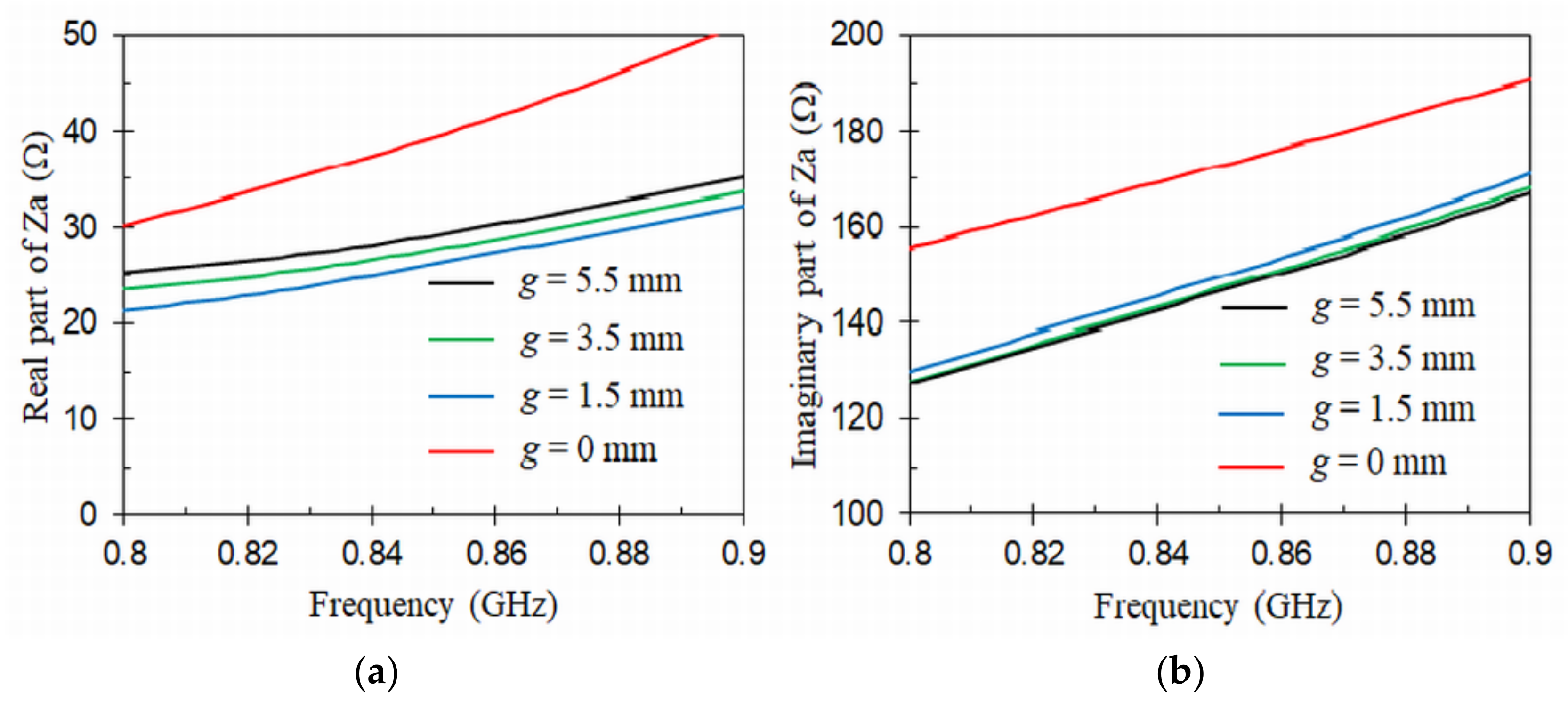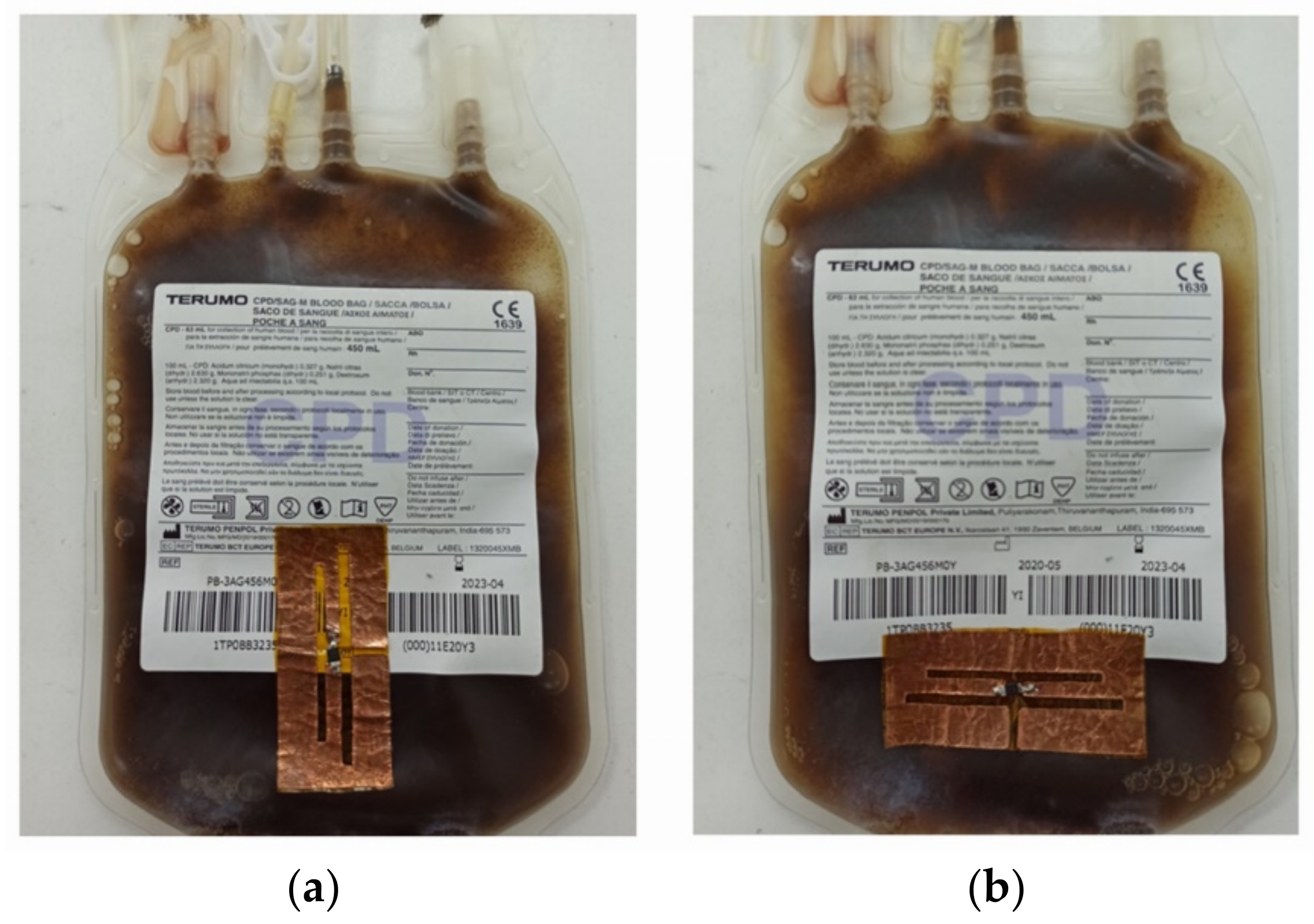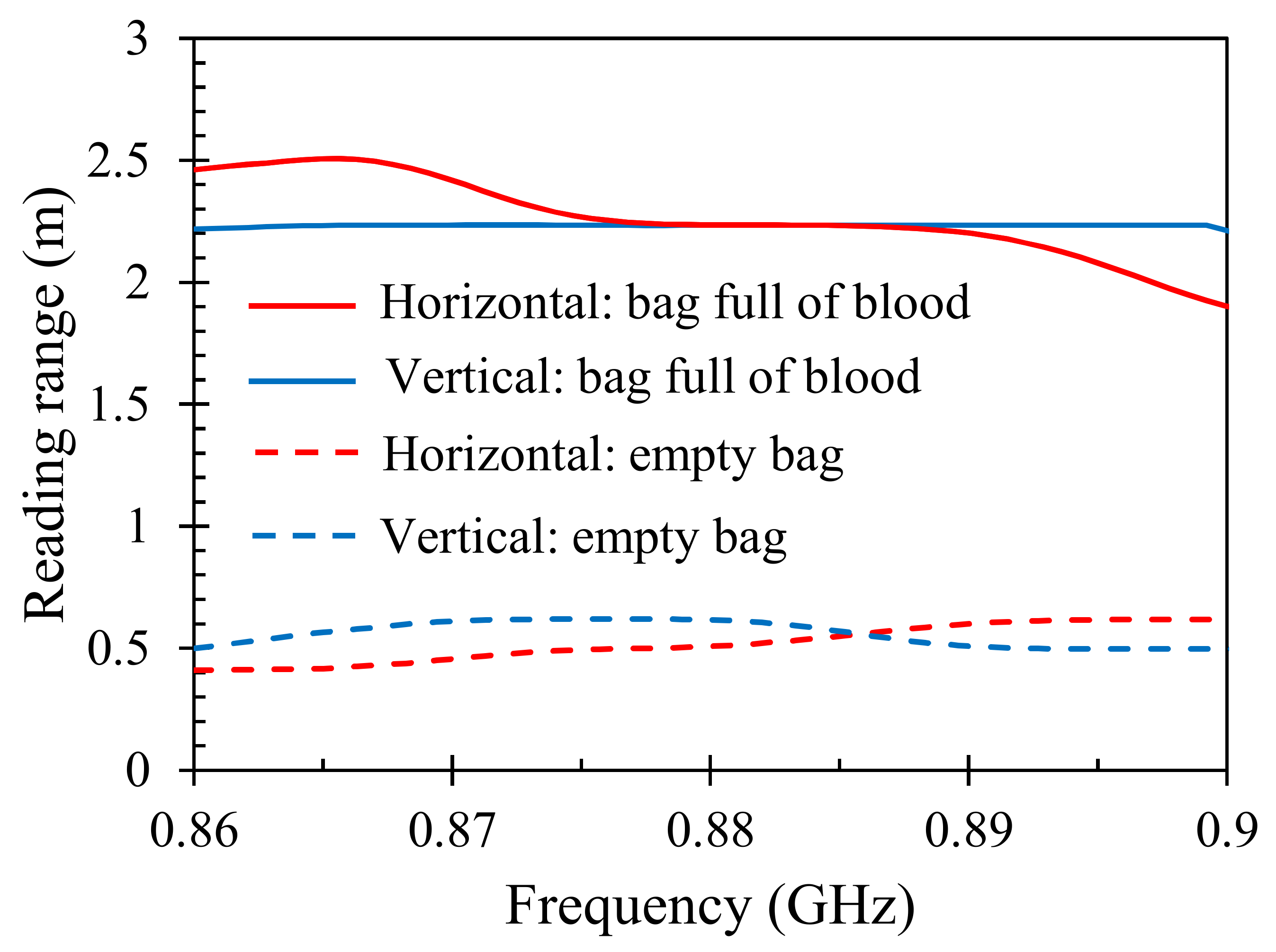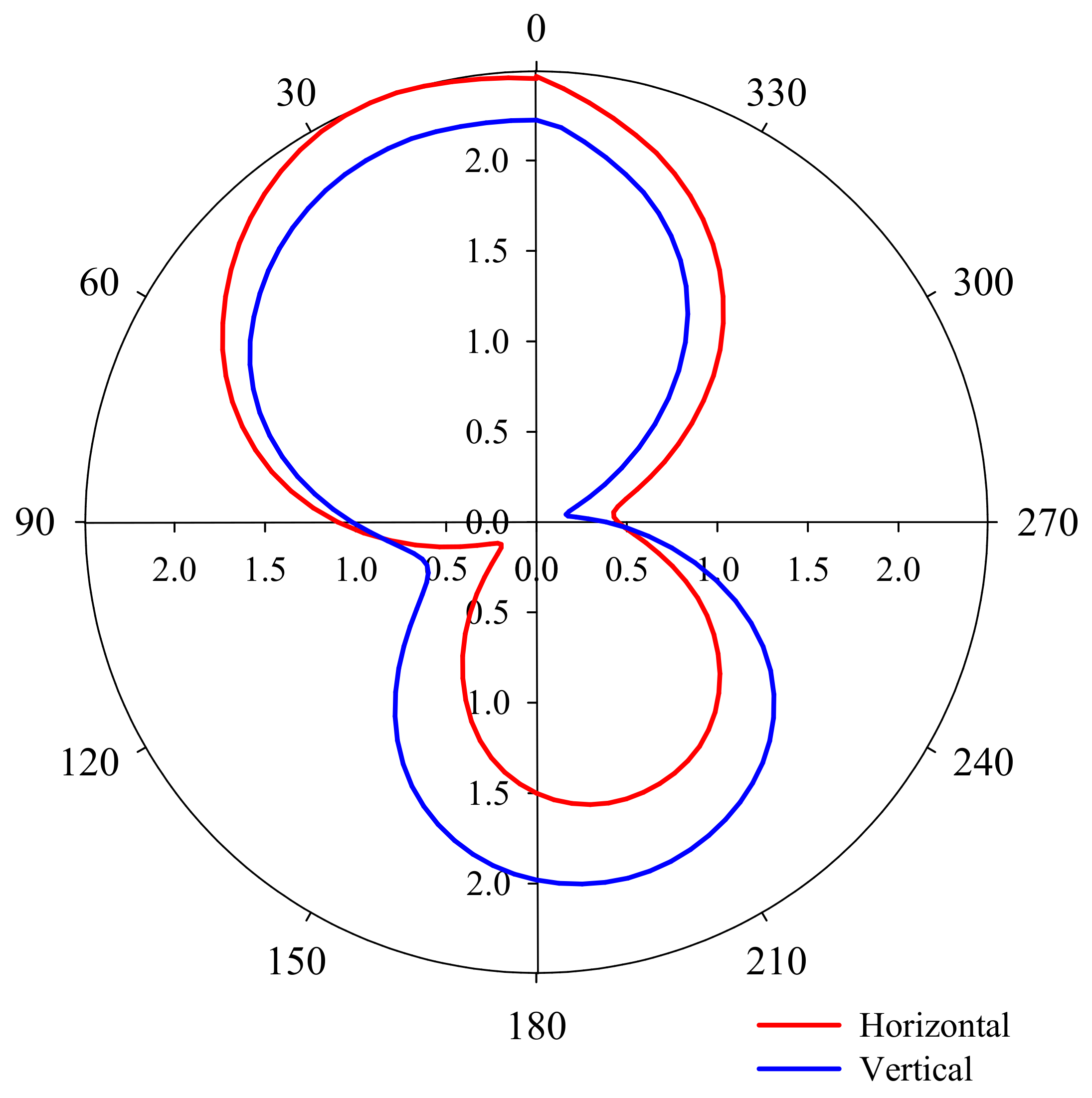A Flexible and Low-Cost UHF RFID Tag Antenna for Blood Bag Traceability
Abstract
:1. Introduction
2. Proposed UHF RFID Tag Antenna
2.1. Antenna Structure
2.2. Design and Optimization
2.3. Parametric Study
2.4. Radiation Diagram
3. Measurement Results and Discussion
3.1. Fabrication and Measurement Setups
3.2. Input Impedance and Power Reflection Coeficient Measurements
3.3. Reading Range
3.4. Comparison with Other Designs
3.5. Effects of UHF Electromagnetic EM Fields on a Blood Bag
4. Conclusions
Author Contributions
Funding
Conflicts of Interest
References
- Zhu, X.; Mukhopaddhyay, S.K.; Kurata, H. Review of RFID technology and its managerial application in different industries. J. Eng. Technol. Manag. 2012, 29, 152–167. [Google Scholar] [CrossRef]
- Zaid, J.; Abdulhadi, A.E.; Denidni, T.A. Miniaturized multi-port microstrip patch antenna using metamaterial for passive UHF RFID-tag sensor applications. Sensors 2019, 19, 1982. [Google Scholar] [CrossRef] [Green Version]
- Hussain, M.; Amin, Y.; Lee, K.G. A compact and flexible UHF RFID tag antenna for massive IoT devices in 5G system. Sensors 2020, 20, 5713. [Google Scholar] [CrossRef] [PubMed]
- Mezzanotte, P.; Palazzi, V.; Alimenti, F.; Roselli, L. Innovative RFID sensors for internet of things applications. IEEE J. Microw. 2021, 1, 55–65. [Google Scholar] [CrossRef]
- Andrade, L.; Figueiredo, J.; Tlemçani, M. A new RFID-identification strategy applied to the marble extraction industry. Electronics 2021, 10, 491. [Google Scholar] [CrossRef]
- Sharif, A.; Yan, Y.; Ouyang, J.; Chattha, H.T.; Arshad, K.; Assaleh, K.; Alotabi, A.A.; Althobaiti, T.; Ramzan, N.; Abbasi, Q.H.; et al. Uniform Magnetic Field Characteristics Based UHF RFID Tag for Internet of Things Applications. Electronics 2021, 10, 1603. [Google Scholar] [CrossRef]
- Chung, Y.; Berhe, T. Long-range UHF RFID tag for automotive license plate. Sensors 2021, 21, 2521. [Google Scholar] [CrossRef]
- Lippi, G.; Chiozza, L.; Mattiuzzi, C.; Plebani, M. Patient and sample identification. Out of the maze? J. Med. Biochem. 2017, 36, 107–112. [Google Scholar] [CrossRef]
- Amendola, S.; Bovesecchi, G.; Palombi, A.; Coppa, P.; Marrocco, G. Design, calibration and experimentation of an epidermal RFID sensor for remote temperature monitoring. IEEE Sens. J. 2016, 16, 7250–7257. [Google Scholar] [CrossRef]
- Camera, F.; Miozzi, C.; Amato, F.; Occhiuzzi, C.; Marrocco, G. Experimental assessment of wireless of axilla temperature by means of epidermal battery-less RFID sensors. IEEE Sens. Lett. 2020, 4, 6002304. [Google Scholar] [CrossRef]
- Camera, F.; Marrocco, G. Electromagnetic-based correction of bio-integrated RFID sensors for reliable skin temperature monitoring. IEEE Sens. J. 2021, 21, 421–429. [Google Scholar] [CrossRef]
- Occhiuzzi, C.; Parrella, S.; Camera, F.; Nappi, S.; Marrocco, G. RFID-based dual-chip epidermal sensing platform for human skin monitoring. IEEE Sens. J. 2021, 21, 5359–5367. [Google Scholar] [CrossRef]
- Xiao, Z.; Chen, X.; Chen, S.; Zhang, Z.; Zhang, H.; Wang, J.; Huang, Y.; Zhang, P.; Zheng, L.; Min, H. An implantable RFID sensor tag toward continuous glucose monitoring. IEEE J. Biomed. Health Inform. 2015, 19, 910–919. [Google Scholar] [CrossRef] [PubMed]
- Gao, M.; Qiang, T.; Ma, Y.; Liang, J.; Jiang, Y. RFID-based microwave biosensor for non-contact detection of glucose solution. Biosensors 2021, 11, 480. [Google Scholar] [CrossRef]
- Caccami, M.C.; Mulla, M.Y.S.; Occhiuzzi, C.; Di Natale, C.; Marrocco, G. Design and experimentation of a batteryless on-skin RFID graphene-oxide sensor for the monitoring and discrimination of breath anomalies. IEEE Sens. J. 2018, 18, 8893–8901. [Google Scholar] [CrossRef]
- Lin, Y.F.; Liao, C.T.; Chen, H.M.; Jiang, Z.D. Compact folded square-loop antenna for reading near-field RFID tags in blood sample tracking system. Electron. Lett. 2017, 53, 1627–1628. [Google Scholar] [CrossRef]
- Khamlichi, M.E.; Alvarez-Melcon, A.; Mrabet, O.E.; Ennasar, M.A.; Hinojosa, J. Flexible UHF RFID Tag for Blood Tubes Monitoring. Sensors 2019, 19, 4903. [Google Scholar] [CrossRef] [Green Version]
- Ibrahim, G.T.; Dutko, M.J. Tracking blood units in medical centers using passive UHF RFID systems. In Proceedings of the American Society for Engineering Education Annual Conference & Exposition, Seattle, WA, USA, 14–17 June 2015; pp. 1–14. [Google Scholar]
- Jeong, M.G.; Lee, W.S. A smart blood bag management system using a load-integrated U-shaped near-field RFID antenna array. IEEE Trans. Antennas Propag. 2019, 67, 1837–1843. [Google Scholar] [CrossRef]
- Fanti, A.; Secci, R.; Boi, G.; Casu, S.; Casula, G.A.; Mazzarella, G.; Montisci, G. A polycarbonate RFID tag for blood chain tracking. In Proceedings of the IEEE International Symposium on Antennas and Propagation and USNC-URSI Radio Science Meeting, Vancouver, BC, Canada, 19–24 July 2015; pp. 356–357. [Google Scholar]
- Choi, J.; Jeon, B.; Chung, Y.; Yeo, J. Design of a UHF RFID tag antenna for RFID-based blood-bag management system. In Proceedings of the International Symposium on Antennas and Propagation (ISAP), Jeju, Korea, 25–28 October 2011; pp. 712–714. [Google Scholar]
- Zaric, A.; Cruz, C.C.; De Matos, A.; Da Silva, M.; Costa, J.R.; Fernandes, C.A. RFID-based Smart blood stock system. IEEE Antennas Propag. Mag. 2015, 57, 54–65. [Google Scholar] [CrossRef] [Green Version]
- Khamlichi, M.E.; Mrabet, O.E.; Alvarez-Melcon, A. A ground slotted UHF tag antenna for blood bags monitoring. In Proceedings of the 19th Mediterranean Microwave Symposium (MMS), Hammamet, Tunisia, 31 October–2 November 2019. [Google Scholar]
- Sharif, A.; Ouyang, J.; Yan, Y.; Raza, A.; Imran, M.A.; Abbasi, Q.H. Low-cost inkjet-printed RFID tag antenna design for remote healthcare applications. IEEE J. Electromagn. RF Microw. Med. Biol. 2019, 3, 261–268. [Google Scholar] [CrossRef] [Green Version]
- Hohberger, C.; Davis, R.; Briggs, L.; Gutierrez, A.; Veeramani, D. Applying radio-frequency identification (RFID) technology in transfusion medicine. Biologicals 2012, 40, 209–213. [Google Scholar] [CrossRef] [PubMed]
- Kiruthika, S.; Sakthi, P.; Kaviya, M.; Vishnupriya, S. Blood bank monitoring and blood identification system using IoT device. Ann. Rom. Soc. Cell Biol. 2021, 25, 182–192. [Google Scholar]
- Pradhan, N.R.; Singh, A.P.; Kumar, V. Blockchain-enable traceable, transparent transportation system for blood bank. In Advances in VLSI, Communication, and Signal Processing; Springer: Singapore, 2021; pp. 313–324. [Google Scholar]
- Islam, M.T.; Alam, T.; Yahya, I.; Cho, M. Flexible radio-frequency identification (RFID) tag antenna for sensor applications. Sensors 2018, 18, 4212. [Google Scholar] [CrossRef] [PubMed] [Green Version]
- Kim, S. Inkject-printed electronics on paper for RF identification (RFID) and sensing. Electronics 2020, 9, 1636. [Google Scholar] [CrossRef]
- Zhang, B.; Zhang, C.; Wang, Y.; Wang, Z.; Liu, C.; He, D.; Wu, Z.P. Flexible anti-metal RFID tag antenna based on high-conductivity graphene assembly film. Sensors 2021, 21, 1513. [Google Scholar] [CrossRef] [PubMed]
- Moraru, A.; Ursachi, C.; Helerea, E. A new washable UHF RFID tag: Design, fabrication and assessment. Sensors 2020, 20, 3451. [Google Scholar] [CrossRef]
- Byondi, F.K.; Chung, Y. UHF RFID conductive fabric tag design optimization. Sensors 2021, 21, 5380. [Google Scholar] [CrossRef]
- Benouakta, S.; Hutu, F.D.; Duroc, Y. Strechable textile yarn based on UHF RFID helical tag. Textiles 2021, 1, 547–557. [Google Scholar] [CrossRef]
- Erman, F.; Hanafi, E.; Lim, E.H.; Mahyiddin, W.A.W.M.; Harun, S.W.; Umair, H.; Soboh, R.; Makmud, M.Z.H. Miniature compact folded dipole for metal mountable UHF tag antenna. Electronics 2019, 8, 713. [Google Scholar] [CrossRef] [Green Version]
- Wagih, M.; Wei, Y.; Komolafe, A.; Torah, R.; Beeby, S. Reliable UHF long-range textile-integrated RFID tag based on a compact flexible antenna filament. Sensors 2020, 20, 3435. [Google Scholar] [CrossRef]
- Rogers RT/Duroid Laminates: RT/Duroid® Laminates-Rogers Corporation. Available online: https://rogerscorp.com/advanced-electronics-solutions/rt-duroid-laminates (accessed on 21 December 2021).
- Kapton FN. Available online: https://www.dupont.com/content/dam/dupont/amer/us/en/products/ei-transformation/documents/EI-10142-Kapton-Summary-of-Properties.pdf (accessed on 21 December 2021).
- NXP Semiconductor. Available online: https://www.nxp.com/docs/en/data-sheet/SL3ICS1002_1202.pdf (accessed on 21 December 2021).
- Qing, X.; Goh, C.K.; Chen, Z.N. Impedance characterization of RFID tag antennas and application in tag co-design. IEEE Trans. Microw. Theory Tech. 2009, 57, 1268–1274. [Google Scholar] [CrossRef]
- Colella, R.; Catarinucci, L.; Coppola, P.; Tarricone, L. Measurement platform for electromagnetic characterization and performance evaluation of UHF RFID tags. IEEE Trans. Instrum. Meas. 2016, 65, 905–914. [Google Scholar] [CrossRef]
- Ennasar, M.A.; Mrabet, O.E.; Mohamed, K.; Essaaidi, M. Design and characterization of a broadband flexible polyimide RFID tag sensor for NaCl and sugar detection. PIER C 2019, 94, 273–283. [Google Scholar] [CrossRef] [Green Version]
- Panescu, D.; Webster, J.G. Effects of changes in electrical and thermal conductivities on radiofrequency lesion dimensions. In Proceedings of the 19th Annual Conference of the IEEE Engineering in Medicine and Biology Society, Chicago, IL, USA, 30 October–2 November 1997; pp. 154–156. [Google Scholar]
- Otin, R. Numerical study of the thermal effects induced by a RFID antenna in vials of blood plasma. Prog. Electromagn. Res. 2011, 22, 129–138. [Google Scholar] [CrossRef] [Green Version]
- Fanti, A.; Casu, S.; Mazzarella, G. A numerical estimation of a RFID reader field and SAR inside a blood bag at UHF. Electronics 2016, 5, 77. [Google Scholar] [CrossRef] [Green Version]











| Parameter | Value (mm) | Parameter | Value (mm) |
|---|---|---|---|
| L | 64 | d | 4 |
| W | 28 | L2 | 31.5 |
| L1 | 43.5 | S2 | 2.5 |
| S1 | 2 | W2 | 9 |
| W1 | 4 | g | 1.5 |
| Ref. | Flexible (Yes/Not) | Antenna Type | Op. Freq. Range (MHz) | Reader Output Power (dBm) | Reading Range (m) | 2-D Size |
|---|---|---|---|---|---|---|
| [19] | Not | Traveling wave | 840–960 | 30 | 0.015 | 0.36 0.15 |
| [20] | Yes | Inductive dipole | 865–868 | 20 | 2 | 0.26 0.17 |
| [21] | Yes | Inductive dipole | 912–914 | - | 1.25 | 0.25 0.04 |
| [22] | Not | Inductive dipole | 902–928 | 20 | - | 0.15 0.15 |
| [23] | Not | Inductive dipole | 865–868 | 30 | 1.28 | 0.11 0.11 |
| [24] | Yes | Capacitive dipole | 890–937 | 28 | 1.5 | 0.12 0.04 |
| This work | Yes | Inductive and capacitive dipole | 865–868 | 30 | 2.5 | 0.18 0.08 |
Publisher’s Note: MDPI stays neutral with regard to jurisdictional claims in published maps and institutional affiliations. |
© 2022 by the authors. Licensee MDPI, Basel, Switzerland. This article is an open access article distributed under the terms and conditions of the Creative Commons Attribution (CC BY) license (https://creativecommons.org/licenses/by/4.0/).
Share and Cite
Khamlichi, M.E.; Alvarez-Melcon, A.; Mrabet, O.E.; Ennasar, M.A.; Hinojosa, J. A Flexible and Low-Cost UHF RFID Tag Antenna for Blood Bag Traceability. Electronics 2022, 11, 439. https://doi.org/10.3390/electronics11030439
Khamlichi ME, Alvarez-Melcon A, Mrabet OE, Ennasar MA, Hinojosa J. A Flexible and Low-Cost UHF RFID Tag Antenna for Blood Bag Traceability. Electronics. 2022; 11(3):439. https://doi.org/10.3390/electronics11030439
Chicago/Turabian StyleKhamlichi, Mohamed El, Alejandro Alvarez-Melcon, Otman El Mrabet, Mohammed Ali Ennasar, and Juan Hinojosa. 2022. "A Flexible and Low-Cost UHF RFID Tag Antenna for Blood Bag Traceability" Electronics 11, no. 3: 439. https://doi.org/10.3390/electronics11030439







